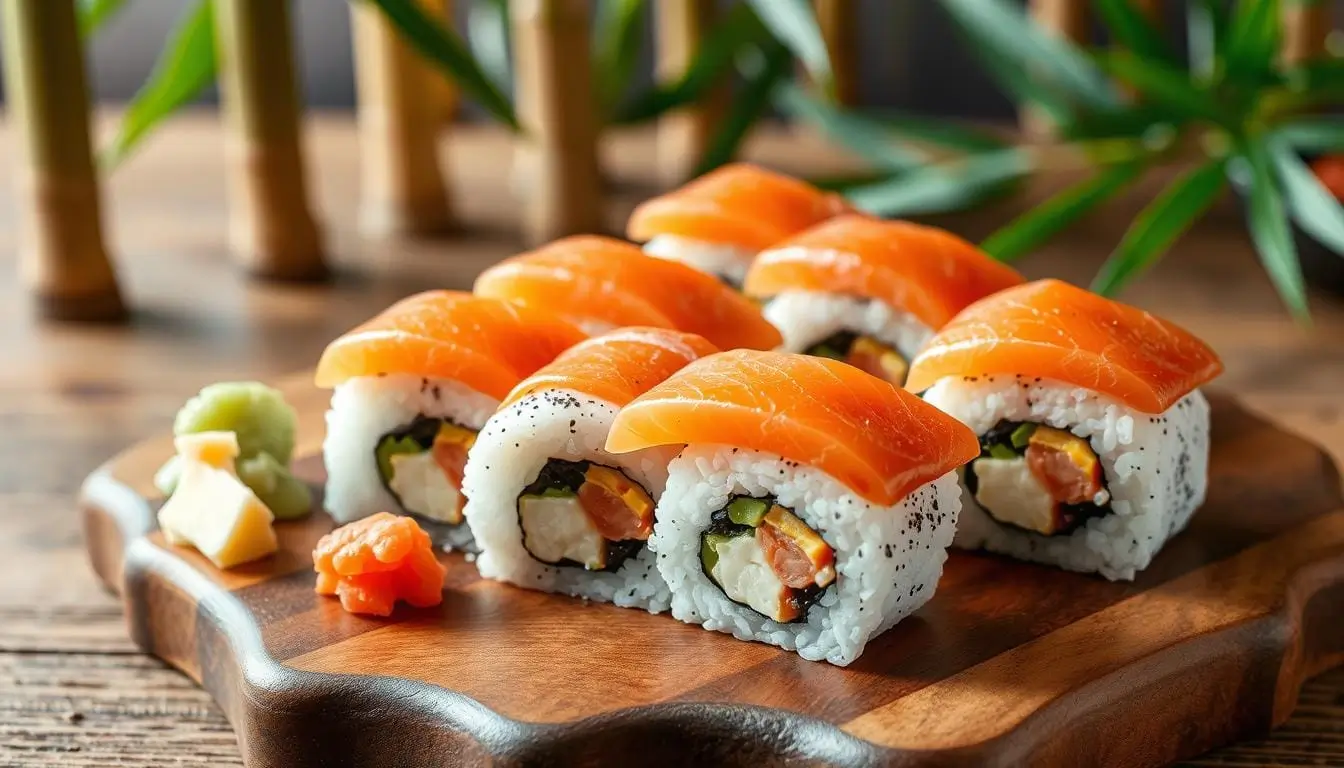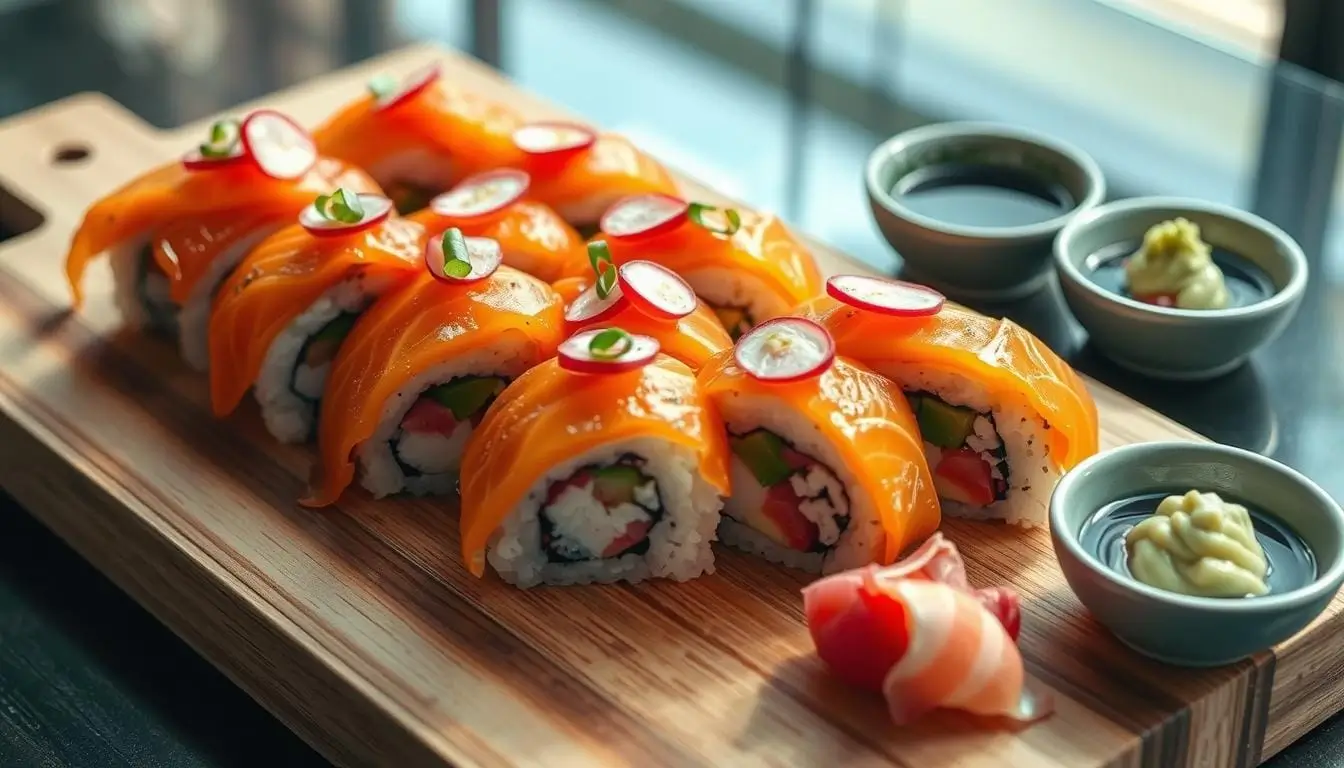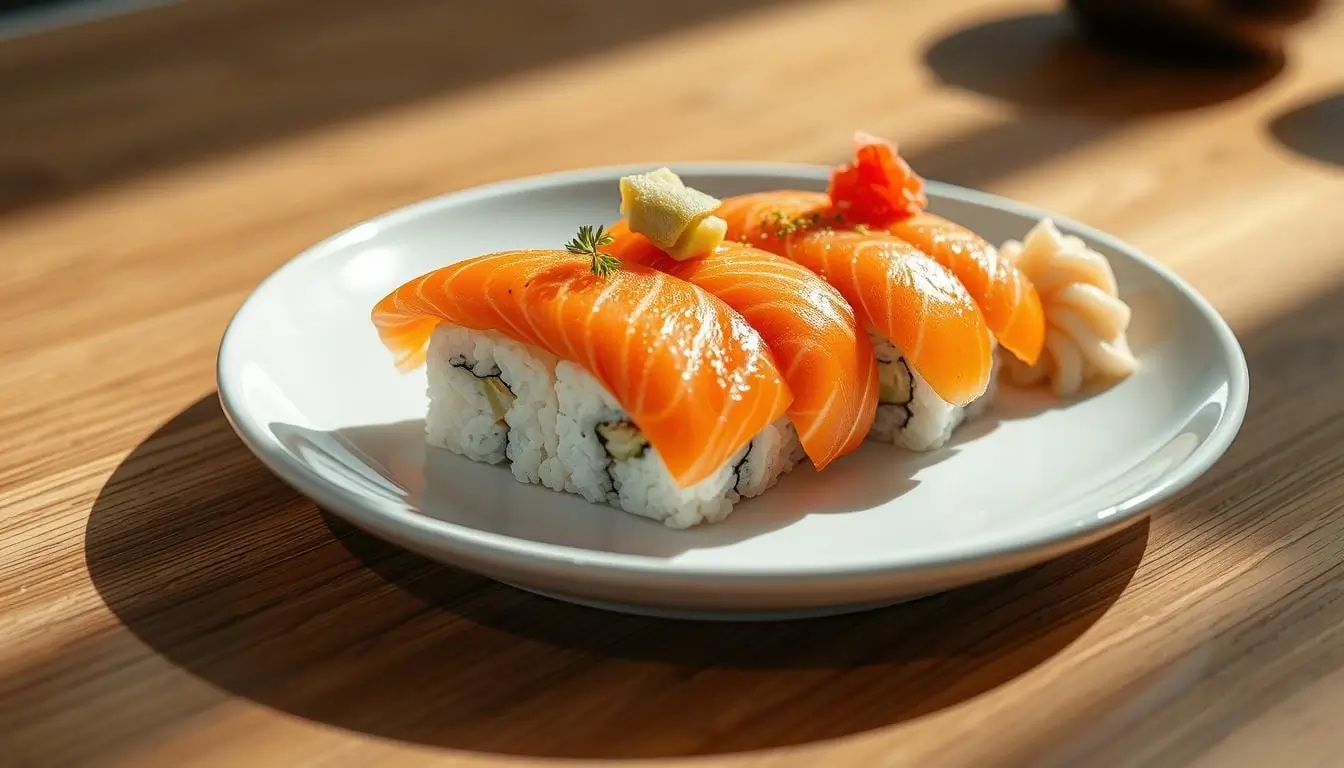I’ll never forget the first time I truly understood what makes a sushi order topped with salmon nyt-worthy. I was sitting at a tiny sushi counter in Portland’s Pearl District, watching the chef’s knife glide through a ruby-red block of salmon like butter. The way he placed each slice over the rice—gentle but confident—it was like watching someone arrange flower petals. That moment completely changed how I thought about sushi orders.
The Art Behind a Perfect Sushi Order Topped with Salmon NYT Style
Here’s the thing about a proper sushi order topped with salmon nyt style (you know, the kind that gets featured in those beautiful New York Times dining reviews): it’s deceptively simple. Just fish and rice, right? Wrong. So wrong. The salmon needs to be pristine—cold enough to hold its shape but not so cold that you lose the buttery texture. The rice should be warm, slightly sticky, seasoned with just enough vinegar to make your taste buds wake up without overwhelming that delicate fish.
I learned this the hard way when I attempted to recreate that restaurant-quality sushi order topped with salmon at home last spring. My salmon was too warm (rookie mistake), and the whole thing turned into a sad, mushy disaster. Cilantro, my cat, even turned his nose up at it, and that boy eats everything.
What Makes Restaurant-Quality Sushi Orders Stand Out
When you’re placing a sushi order topped with salmon nyt critics would approve of at a quality Japanese restaurant, there are a few telltale signs you’re getting the good stuff:
The salmon itself should glisten. Not in a weird, fishy way, but with that natural oil content that premium cuts have. King salmon or Norwegian salmon are typically your best bets, though I’ve had incredible sockeye salmon nigiri during summer months here in the Pacific Northwest. If you’re curious about different salmon varieties and their flavor profiles, I dive deep into that in my king salmon recipe guide—it’ll help you understand what makes each type special for your sushi order.
The rice temperature matters more than most people realize. Traditional sushi rice (shari) should be body temperature—warm enough to contrast with the cool fish but not hot enough to start cooking it. Trust me on this one. I’ve tasted the difference, and once you notice it, you can’t un-notice it.
Portion balance is everything. The fish-to-rice ratio should let both ingredients shine. Too much rice and you’re just eating a rice ball with a salmon hat. Too little rice and the fish texture gets overwhelming.
Decoding the NYT-Style Sushi Experience
The New York Times dining section has featured countless sushi spots over the years, and when you see a sushi order topped with salmon nyt featured in their reviews, there’s usually a pattern to what makes these places special. They’re not necessarily the most expensive (though some definitely are), but they share certain qualities that elevate a simple salmon-topped sushi order into something memorable.
Sourcing transparency is huge. The best places will tell you exactly where their fish came from—sometimes down to the specific fishing vessel. I remember reading a NYT review of a Manhattan sushi bar where the chef personally selected fish at 4 AM from the Fulton Fish Market. That level of dedication? You can taste it in every sushi order.
Minimal but intentional garnishes make a difference too. A tiny dab of wasabi between the rice and salmon. Maybe a whisper of yuzu zest or a single shiso leaf. Nothing that screams for attention, but everything there for a reason.

How to Order Like You Know What You’re Doing
Okay, real talk: ordering sushi used to intimidate me. All those Japanese terms, the etiquette rules, the fear of looking like a total amateur. But here’s what I’ve figured out after years of perfecting my sushi order topped with salmon approach.
Start with salmon nigiri (sake nigiri) if you’re at a new place. It’s a great baseline for judging quality because salmon is so popular that any decent sushi restaurant needs to nail it. If they can’t get salmon right, the rest probably isn’t worth exploring.
Consider trying salmon variations beyond the basic nigiri when placing your sushi order. Aburi salmon (torch-seared) adds this incredible smoky dimension that I’m completely obsessed with. The fat renders slightly, the edges caramelize, and honestly? It’s one of those things that makes me understand why people become food writers just to describe moments like this. Speaking of variations, if you love creative salmon presentations, you should check out my Alaska roll recipe—it’s a fun way to enjoy salmon in roll form with some unexpected twists.
Don’t skip the traditional accompaniments. Pickled ginger (gari) isn’t just there to look pretty—it cleanses your palate between different fish types. And that little mound of wasabi? Use it sparingly, mixed into your soy sauce or placed directly on the fish, depending on your preference.
My Personal Salmon Sushi Philosophy
After years of eating (and occasionally butchering) sushi orders, I’ve developed some opinions. Some might be controversial, but I stand by them.
Fresh doesn’t always mean never-frozen. I know, I know—everyone wants “fresh, never frozen” fish. But here’s the truth: most sushi-grade salmon has been flash-frozen to kill parasites. It’s food safety, and it doesn’t affect quality if done properly. What matters is how it’s thawed and handled afterward. If you’re working with salmon at home and want to understand quality markers better, my post comparing smoked salmon vs hot smoked salmon gets into the nitty-gritty of salmon preparation techniques.
Season matters. Wild salmon season (typically May through September) is when you’ll get the most flavorful salmon nigiri in your sushi order topped with salmon. Outside those months, responsibly farmed Norwegian or Scottish salmon can be absolutely incredible. Don’t be a snob about it—good fish is good fish.
Simplicity usually wins. Those elaborate rolls with seventeen ingredients and three sauces? Fun occasionally, but they hide the quality of the fish. A perfect sushi order topped with salmon nyt style needs nothing more than pristine fish, rice, and maybe a touch of soy sauce.
Making Your Sushi Order Count
When you’re sitting at that sushi counter (or scrolling through a delivery app—no judgment here), think about the complete experience. A well-planned sushi order topped with salmon should be part of a balanced meal that showcases different flavors and textures.
I usually pair salmon nigiri with something more delicate like tai (sea bream) or something richer like toro (fatty tuna) if I’m feeling fancy. The contrast helps you appreciate each fish’s unique character. And honestly? It makes the meal feel more intentional, more special.
Temperature timing is something restaurants understand but home delivery can mess up. If you’re ordering takeout sushi, eat it within 20-30 minutes. After that, the rice starts drying out and the whole experience degrades. I learned this during pandemic takeout experiments that didn’t always go as planned.
The Ritual of Eating Salmon Nigiri
There’s an art to actually eating nigiri that took me embarrassingly long to learn. You’re supposed to flip it fish-side down onto your tongue (!) so the salmon hits your taste buds first. Dip the fish side—not the rice—into soy sauce so the rice doesn’t fall apart and absorb too much sodium.
But you know what? Sometimes I just eat it however feels right in the moment. The police aren’t coming to arrest you for sushi crimes. The point is enjoying your sushi order topped with salmon however makes you happiest.
Why This Matters Beyond Just Dinner
Food has this amazing ability to transport us, right? A well-prepared sushi order topped with salmon nyt style connects you to Japanese culinary traditions stretching back centuries, to the fishermen who caught that salmon, to every chef who practiced their knife skills until they could slice fish blindfolded.
It’s also deeply connected to sustainability. When you’re paying attention to where your salmon comes from, you’re participating in a larger conversation about ocean health and responsible fishing practices. The best restaurants—the ones that earn those glowing NYT reviews—take this seriously. If you’re curious about selecting quality salmon for home cooking, I’ve written a comprehensive guide to the best canned salmon that covers sustainability ratings and flavor profiles.
Bringing It All Together
Looking for more ways to explore salmon at home? If you love the clean, simple flavors of a quality sushi order topped with salmon, you might really enjoy my grilled salmon with quinoa salad recipe. It captures that same fresh, healthy vibe in a weeknight-friendly format that doesn’t require sushi-grade fish or expert knife skills. Or if you’re feeling adventurous, my pineapple chili salmon brings some sweet heat that’s totally different but equally delicious.
The beauty of a great sushi order topped with salmon nyt style lies in its honest simplicity. No hiding behind heavy sauces or complicated preparations—just exceptional ingredients treated with respect and skill. Whether you’re splurging at a high-end omakase counter or grabbing takeout from your favorite neighborhood spot, understanding what makes salmon sushi special helps you appreciate every bite just a little bit more.
And honestly? That’s what makes food worth writing about. Not just the eating, but the understanding. The connection. The moment when you bite into that perfect piece of salmon nigiri and everything just clicks.
Trust me, once you’ve experienced a truly great sushi order topped with salmon nyt critics would rave about, you’ll never settle for mediocre again. Your taste buds will thank you.


Fresh Sushi Order Topped with Salmon NYT – Dining Guide
Ingredients
Method
- Step 1: Prepare the Sushi RiceRinse the rice: Place rice in a bowl and rinse under cold water until the water runs clear (about 3-4 rinses). This removes excess starch for that perfect sticky texture.
- Cook the rice: Combine rice with 1¼ cups water in a rice cooker or saucepan. Cook according to package instructions. (Pro tip: I always let my rice sit for 10 minutes after cooking to absorb moisture evenly.)
- Season the rice: In a small bowl, mix rice vinegar, sugar, and salt until dissolved. Transfer warm rice to a large, shallow bowl (wooden hangiri is traditional, but any wide bowl works). Gently fold in the vinegar mixture with a wooden spoon, fanning the rice to cool it to body temperature (about 98°F/37°C). Don’t overmix—you want to keep the grains intact.
- Step 2: Prepare the Salmon
- Check for quality: Ensure your salmon is sushi-grade, with a vibrant color and glossy sheen. If it smells fishy, it’s not fresh enough for nigiri.
- Slice the salmon: Using a sharp knife, cut the salmon into thin, uniform slices (about 3×1 inches, ¼-inch thick). Angle your knife at 45 degrees for clean cuts. (I messed this up my first time—uneven slices make for wonky nigiri!)
- Chill the salmon: Keep slices refrigerated until ready to assemble to maintain that firm, cool texture.
- Step 3: Shape the Nigiri
- Wet your hands: Dip your hands in a bowl of water mixed with a splash of rice vinegar to prevent sticking.
- Form rice balls: Scoop about 1-1½ tbsp of rice and gently shape into an oval (about 2 inches long). Press lightly to hold the shape without compacting too much.
- Add wasabi (optional): Dab a tiny amount of wasabi on one side of a salmon slice for a subtle kick.
- Assemble: Place a salmon slice over the rice, gently pressing so it drapes naturally. The fish should slightly overhang the rice for that perfect NYT-style presentation.
- Step 4: Serve
- Plate with care: Arrange nigiri on a clean plate with pickled ginger and a small dish of soy sauce. Add garnishes like shiso or yuzu zest if you’re feeling fancy.
- Serve immediately: Nigiri is best eaten fresh to enjoy the contrast of warm rice and cool salmon.
Notes
- Calories: 60-70 kcal
- Protein: 4g
- Fat: 2g
- Carbohydrates: 8g
- Rice temperature is key: The rice should be warm (body temperature) to contrast with the cold salmon. Too hot, and it’ll start cooking the fish. Too cold, and it loses that soft, sticky vibe.
- Don’t skip the rinse: Rinsing the rice ensures it’s not too starchy, which is critical for that authentic sushi texture.
- Knife skills matter: A sharp, non-serrated knife makes all the difference for clean salmon slices. I learned this after mangling my first batch—trust me, invest in a good knife.
- Sourcing salmon: Look for sushi-grade salmon at reputable fish markets or Asian grocery stores. If you’re unsure about quality, check out my guide to the best canned salmon for tips on evaluating fish quality and sustainability.
- Storage tip: If you’re not eating right away, store rice and salmon separately in the fridge. Assemble just before serving to avoid soggy rice.
- Rice too sticky? You might have overmixed or added too much water. Next time, measure precisely and fold gently.
- Salmon falling off? Your rice balls might be too loose. Press a bit firmer when shaping, but don’t squash them.
- Fish tastes off? Always double-check the freshness of your salmon. If it’s not sushi-grade, don’t risk it.
